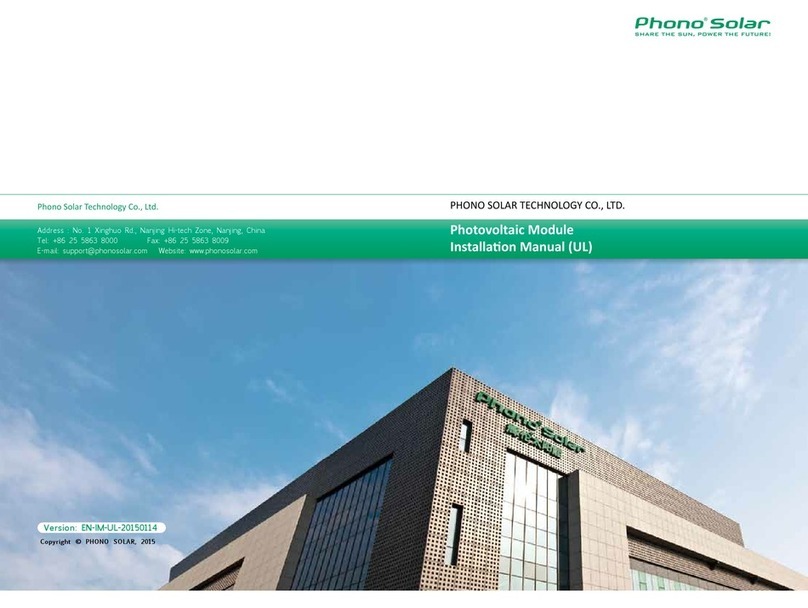MECHANICAL INSTALLATION
(Note:Allinstructionshere afterareforreferenceonly. A licensed/qualifiedperson or
installer must be responsible for the design, installation, mechanical load calculation and
security of the photovoltaic system.)
3.1
Select suitable locations for installation
Select a suitable location for installing the modules.
PHONO SOLAR recommends that to achieve the best performance the modules
should face south in northern latitudes and north in southern latitudes. The
exact tilt angle and orientation of mounted modules should be recommended by a
licensed/ qualified installer.
The modules should be completely free of shade at all times.
Do not place the modules near a location where flammable gases are either
generated or collected.
Note1: Saline environments can accelerate the processes of electrical insulation
losses and galvanic corrosion, especially when different metals with high
electrochemical potential come into contact each other.
In saline environments, based on the distance to seashore, Phono
Solar generally
classifies coastal PV installation into three different levels:
From 0 up to 50 meters, Phono Solar does not recommend any installation due
to concerns for salt-mist corrosion.
From 50 to 500 meters, Phono Solar regards this as “Near -Coast”
installation requiring adherence to salt-mist corrosion prevention.
From 500 meters and onwards, Phono Solar estimates the risk of salt mist
corrosion is minor and only requires annual preventive maintenance.
In “Near- Coast” installation, Phono Solar PV modules must be installed
under the following conditions:
During the installation, do not scratch or break the corrosion-resistant
coating (e.g.
electroplated layer, oxidized coating, etc.) on the modules and mounting
systems.
Phono solar recommends that the modules shall be mounted with a minimum tilt
angle of 10° in respect to the horizen , or follow the recommendations of
experienced PV module installers.
Use corrosion-resistant materials (e.g. stainless steel SUS 316) for
components (nut,
bolt, gasket, etc.) to fixing the modules and mounting systems.
To avoid possible galvanic corrosion between the aluminum frame and the
support structure, mica lamination, or other silicone, or fluoride made
gasket shall be interposed between the two metals
When grounding the module frames, stainless steel hardware must also
be used. To prevent salt corrosion to grounding block, fluorocarbon varnish
could be sprayed on the grounding block thoroughly to form an anti-corrosion
coating (at least 40um thick) or a pad of butyl plaster covering could be
placed on the grounding block completely.
To ensure optimum module performance for near-coast installation, a
system maintenance service of every three months is generally recommended and
additionally the following maintenance measures shall be taken:
Check the frame, mounting system, grounding block and other junction areas
for potential signs of corrosion.
Clean the frame, mounting system, grounding block and other junction
areas from salt and dust accumulation.
To repair the rusty areas, apply butyl plaster or fluorocarbon varnish
spray to cover the area thoroughly after clean the salt and other dust
accumulations around the rusty areas.
Note2 :In environments where ammonia is present, Phono Solar PV modules must be
installed under the following conditions:
When fixing the modules using the 8 mounting slots, all the hardware (washers,
screws and nuts) shall be made of stainless steel;
To avoid possible galvanic corrosion between the aluminum frame and the support
structure, PVC washers or neoprene tape shall be interposed between the two metals;
When grounding the module frames, stainless steel hardware must also be used.
Note3 :If you are planning to use the PV modules where the water damage
(Humidity: > 85RH%) may be possible, please consult with Phono Solar technical
support first to determine an appropriate installation method and module type ,
or to determine whether the installation is possible.
3.2
Select suitable mountingrails
Please observe the safety regulations and installation instructions included
with the






























